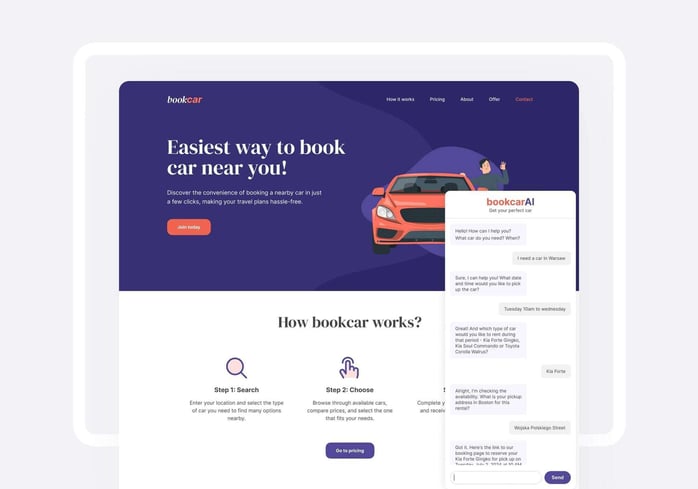Generative AI with Large Language Models
.jpg?width=1200&height=630&name=Technology%20(1).jpg)
This article dives into their workings, practical applications, and the advantages they bring across different industries.
Key Takeaways
- Generative AI and Large Language Models (LLMs) complement each other, enhancing content creation and personalization through their respective strengths in creativity and contextual understanding.
- Generative AI employs techniques like recurrent neural networks (RNNs) and generative adversarial networks (GANs) to produce unique content, while LLMs, such as OpenAI’s GPT-4, excel in text-based tasks using natural language processing (NLP).
- Challenges for these technologies include ethical concerns, data quality, and resource requirements, necessitating robust governance and significant computational investments for successful implementation.
Understanding Generative AI and Large Language Models
Generative AI and Large Language Models (LLMs) are two fundamental aspects of modern artificial intelligence, contributing substantially to innovation and creativity. Their shared objective is content generation, but they exhibit significant differences in their methodologies, capabilities, and applications. Grasping these distinctions is vital for the effective use of each technology across various tasks and domains, which will significantly influence the results of their application.
GenAI focuses on creating models that produce original content such as images, music, and text using complex machine-learning algorithms, including recurrent neural networks (RNNs) and generative adversarial networks (GANs). On the other hand, LLMs use natural language processing (NLP) to understand and generate human-like text-based content, excelling in tasks centered around language understanding and text generation.
Companies like OpenAI are at the forefront of enhancing LLM capabilities and developing innovative applications in natural language understanding and generation. The combination of these technologies enables the creation of multimodal content, such as text descriptions for images or soundtracks for videos, making them incredibly versatile across various creative endeavors.
What Is Generative AI?
Generative AI is a subset of artificial intelligence that aims to develop models capable of generating original content, such as images, music, and text. These models can create diverse and unique outputs. Techniques such as recurrent neural networks (RNNs) and generative adversarial networks (GANs) are employed to generate this diverse content. These models are particularly well-suited for complex, creative tasks that require a variety of outputs, enhancing the creative process.
Generative AI has a wide range of applications, which include image manipulation, artistic creation, and providing support for creative writing. These applications demonstrate the versatility and potential impact of this technology. For instance, Generative AI can assist in producing unique pieces of art, composing music, or even drafting entire articles, thereby reducing the initial workload for content creators and enabling a more efficient creative process.
What Are Large Language Models (LLMs)?
Large Language Models (LLMs) are specialized AI models that utilize natural language processing to understand and generate human-like text. These large language model examples are designed to excel in language-related tasks, relying on large, clean text corpora to offer accurate and coherent responses. Notable examples include OpenAI’s GPT-3 and its successor GPT-4, which are renowned for their ability to produce contextually appropriate and cohesive text.
LLMs are employed in a variety of applications, from chatbots and virtual assistants to content translation and text completion. By leveraging vast amounts of training data, these models can understand the nuances of language and generate text that is not only coherent but also contextually relevant. This makes them invaluable tools in fields requiring natural language understanding and generation.
How Generative AI Works with Large Language Models?
Generative AI models and Large Language Models (LLMs) can complement each other effectively, enhancing various applications like content generation, personalization, and multimodal content creation. By combining the creative capabilities of Generative AI with the contextual understanding provided by LLMs, it’s possible to produce content that is both engaging and contextually relevant.
This synergy is particularly evident in applications such as content personalization and storytelling, where the ability to generate coherent and contextually appropriate content is crucial. Moreover, major tech firms invest in new generative AI tools, which underscores the growing importance of these technologies in the modern digital landscape.
Combining Strengths
The combination of Generative AI’s creativity and LLMs’ contextual understanding results in the generation of coherent and contextually accurate content. For instance, while LLMs excel at interpreting language subtleties, Generative AI specializes in producing precise translations and localized content versions, thereby improving the overall output quality.
Additionally, this combination can improve the conversational abilities of chatbots, providing more natural and human-like interactions. By leveraging the strengths of both technologies, it is possible to produce multimodal content, such as creating text descriptions for images or soundtracks for videos, thereby enhancing the user experience across various domains.
Real-World Applications
In real-world applications, the combination of Generative AI and LLMs is being used to enhance language translation and localization, improving the accuracy and contextual appropriateness of real-time translations. This advantage is especially useful for companies aiming to broaden their global presence and reach a varied audience.
Chatbots and virtual assistants also benefit from this combination, delivering more natural and engaging interactions. In the realm of marketing and sales, Generative AI and LLMs are used to personalize customer experiences and optimize campaign strategies, making them indispensable tools for modern businesses.
Key Benefits of Using Generative AI with Large Language Models
Merging Generative AI with Large Language Models (LLMs) provides multiple benefits such as advanced content creation, refined personalization, and superior contextual comprehension. These advantages are revolutionizing the way businesses and individuals generate and engage with content, thereby streamlining processes and making them more effective.
Generative AI enables businesses to streamline content creation, enhancing productivity and creativity. LLMs, on the other hand, make sense of shopper preferences and generate personalized recommendations, while also providing contextually accurate responses. This combination ensures that the content generated is not only relevant but also engaging and tailored to individual needs.
Enhanced Content Creation
Generative AI models, including the generative AI model trained, are capable of creating a diverse range of content such as:
- Text,
- Images,
- Code,
- Poetry,
- Artworks.
They shine at creating content types such as images, music, and code, thus alleviating the initial workload for content creators. For instance, tools like GPT-3 can draft emails, articles, reports, and presentations, making the content creation process more efficient.
When combined with LLMs, Generative AI can produce original, contextually relevant creative content across different domains. This includes automating the creation of product descriptions, blog posts, email campaigns, and social media content, tailored for different channels, LLMs also improve content summarization by assessing context and key points and creating condensed versions that capture the essence of the original material.
Improved Personalization
Generative AI and LLMs are proficient at tailoring content for individual users, which includes targeted product recommendations, personalized ads, and user-specific content. LLMs generate personalized recommendations by grasping shopper preferences, while Generative AI concocts customized content based on these preferences, thereby enriching the overall customer experience.
In the realm of e-commerce, Generative AI boosts the customer experience by:
- Generating tailored shopping recommendations.
- Refining product discovery.
- Responding to fashion-related inquiries.
- Offering styling advice, in conjunction with recommendation algorithms.
Better Contextual Understanding
Large Language Models (LLMs), also known as foundation models, achieve contextual understanding and memory by incorporating memory units in their architectures, allowing them to store and retrieve relevant information. This enables them to produce contextually accurate responses, enhancing the quality of generated text.
For instance, LLMs like GPT-3 and PaLM 2 enhance the quality of generated text by understanding the context and generating coherent responses. This strength in contextual understanding ensures that the content generated is not only relevant but also coherent and accurate, making LLMs invaluable tools in various applications.
Practical Use Cases of Generative AI and LLMs
Generative AI and LLMs are being applied across various sectors, including e-commerce, healthcare, and entertainment, transforming industry processes and driving innovation. These technologies are not only enhancing content creation and personalization but also enabling new applications and improving existing ones.
In sectors like e-commerce, healthcare, and entertainment, Generative AI and LLMs are making significant impacts. From generating personalized product descriptions to assisting in drug discovery and enhancing gaming experiences, the practical use cases of these technologies are vast and varied.
E-commerce
In e-commerce, Generative AI is used to generate detailed product descriptions and marketing content, making online shopping more personalized and engaging. LLMs enhance chatbots and virtual assistants by providing context and memory capabilities, enabling more natural and interactive conversations.
Generative AI chatbots can provide high-quality, personalized interactions in real time, helping shoppers make decisions and improving customer support. Additionally, LLM-powered chatbots can modify user queries to provide more accurate search results, enhancing the shopping experience by answering complex queries directly.
As an example of Generative AI in e-commerce, our internal R&D team developed an AI-powered sales advisor to explore how AI-driven personalization can enhance the online shopping experience. The solution analyzes customer preferences and offers tailored product recommendations across multiple price ranges, using a vector database to quickly process product data. We integrated GPT-4 for natural language responses and created a chatbot that operates seamlessly across web, mobile, and in-store platforms.

Healthcare
Generative AI assists in drug discovery by predicting molecular structures with high accuracy, accelerating the development of new medications. In healthcare, these technologies are also used for interpreting electronic medical record (EMR) data, automating note-taking during patient appointments, and proposing actions such as medication orders.
Companies like Oracle Cerner have integrated Generative AI into their EHR systems to streamline patient interactions and improve clinical workflows. By interpreting clinical text and structured data from EMRs, Generative AI models can create a machine-understandable representation of a patient, similar to a digital twin, enhancing predictive performance and patient care.
As an example of Generative AI in healthcare, Merck partnered with Netguru to accelerate its drug discovery process. By implementing an AI R&D Assistant, Merck reduced the chemical identification timeline from 6 months to just 6 hours. This innovation enabled Merck to scale its R&D efforts more efficiently while maintaining compliance with healthcare regulations.

Entertainment
In the entertainment industry, Generative AI is transforming scriptwriting by generating storylines and dialogues, as well as creating virtual characters for movies. These technologies can also assist in the creation of more interactive and personalized gaming experiences by developing unique narratives and character interactions.
Generative AI is also used to create new music pieces by learning styles and patterns from input music data. Tools like OpenAI’s DALL-E and platforms like Midjourney use deep-learning techniques to produce imaginative artistic images, while Runway supports creative professionals with capabilities like realistic image creation, photo manipulation, and 3D model generation.
Education
Generative AI is transforming education by enabling personalized learning experiences and automating content creation. AI-powered tools can generate customized learning materials such as quizzes, lesson plans, and textbooks tailored to individual students' needs and learning styles. This reduces the time educators spend on administrative tasks, allowing them to focus more on engaging with students. Additionally, Generative AI can support language learning by providing real-time feedback on pronunciation, grammar, and sentence structure, helping learners improve faster and more effectively.
In the classroom, AI-powered virtual tutors assist students by offering personalized explanations and breaking down complex concepts into simpler terms, adapting to each student’s pace. Generative AI also supports automated grading, providing consistent evaluations and freeing up educators' time for more direct interaction with students.
Here’s an example of how Generative AI can transform education: NewGlobe, a leader in improving basic education, worked with Netguru to speed up the creation of teacher guides. What once took 4 hours per guide was reduced to just 45 seconds, making the process much faster. This innovation allowed NewGlobe to expand quickly into new regions, improving efficiency and scalability.

Challenges and Considerations
While the potential of Generative AI and LLMs is immense, several challenges and considerations must be addressed. These include ethical concerns, data quality, and resource requirements. Ensuring the ethical application of these technologies and managing the associated risks is crucial for their successful deployment,
The ethical implications of AI-generated content, the quality and availability of training data, and the resource demands of deploying and maintaining AI models are significant challenges that must be navigated. Addressing these challenges is essential for leveraging the full potential of Generative AI and LLMs,
Ethical Concerns
Ethical considerations in Generative AI involve addressing biases and ensuring fairness in AI-generated content. LLMs can inadvertently discriminate, particularly in applications like recruitment, and privacy infringements are a primary ethical concern when using these technologies,
Robust regulatory frameworks and proactive ethical governance are crucial to handling the ethical implications of AI-generated content. The integration of ethical design principles during AI development can help mitigate ethical issues and ensure the responsible use of these technologies,
Data Quality and Availability
For Generative AI to produce meaningful outputs, it is crucial to have high-quality and diverse training data. This ensures that the AI can learn to generate accurate and varied results. The accuracy of LLMs is heavily dependent on the quality and domain-specificity of the training data, acquiring high-quality data is a critical step in developing reliable AI models.
However, acquiring such data can be challenging and resource-intensive. The availability of diverse and representative datasets is crucial for reducing biases in AI models and ensuring that the outputs are accurate and fair. Data scientists must work diligently to curate and maintain these datasets to support the development of robust AI models.
Resource Requirements
Training large Generative AI models requires substantial computational power and energy. Deploying AI models at scale can necessitate significant financial investment in infrastructure, including:
- High-performance hardware such as TPUs and GPUs.
- Robust storage systems.
- Efficient cooling systems.
- Reliable power supply.
These requirements can make it challenging for organizations to adopt and implement AI technologies on a large scale.
Additionally, ongoing maintenance and updates of AI models contribute to the resource demands over time. Organizations must be prepared to invest in the necessary resources to support the deployment and continuous improvement of these AI models, ensuring that they remain effective and up-to-date.
Future Trends in Generative AI and Large Language Models
Generative AI and Large Language Models (LLMs) hold a future filled with exhilarating prospects. Innovations in model architecture, amalgamation with other technologies, and the broadening of use cases are poised to fuel innovation and instigate transformation across diverse industries.
As these technologies continue to evolve, their role will expand beyond text generation and sentiment analysis, becoming integral to almost all business applications. From enhancing traditional computing paradigms to offering creative and improvisational capabilities, the potential of Generative AI and LLMs is immense.
Advances in Model Architecture
Recent innovations in AI model architecture have concentrated on the evolution of neural networks and transformers, empowering large language models to encode and decode natural language with greater efficiency. The advent of highly advanced neural networks has fostered the growth of large language models capable of processing training data at the scale of hundreds of billions of words.
Next-generation AI models are leveraging hardware accelerators, such as TPUs and GPUs, to achieve faster processing speeds and lower latency. These advances in model architecture are making AI models more efficient and high-performing, enabling them to handle more complex and diverse tasks.
Integration with Other Technologies
Generative AI is increasingly being integrated with IoT devices to enhance automation and predictive maintenance capabilities. This integration allows for more efficient and effective management of IoT systems, improving operational efficiency and reducing downtime through the use of advanced AI systems.
Combining AI with augmented reality (AR) is enabling more immersive and interactive user experiences in various industries like retail and education. For example, Generative AI can generate captions or text prompts for created content, enhancing its utility in multimedia applications and providing users with more engaging and informative experiences.
Expanding Use Cases
Going forward, Generative AI and LLMs will administer an increasing number of business applications and domains, becoming increasingly intelligent and proficient. The anticipation of Generative AI’s potential to revolutionize various industry processes is stirring considerable market enthusiasm.
Generative AI tools are expected to find new applications in sectors like software development, enhancing productivity and creativity. Additionally, the education sector is beginning to adopt Generative AI for developing customized learning modules and enhancing student engagement, showcasing the versatile applications of these technologies.
Summary
Generative AI and Large Language Models (LLMs) are transforming the way we create and interact with content. By combining the creative capabilities of Generative AI with the contextual understanding of LLMs, these technologies are enhancing content creation, personalization, and contextual understanding across various domains.
The future of Generative AI and LLMs is promising, with advances in model architecture, integration with other technologies, and expanding use cases driving innovation and transformation. As we continue to explore the potential of these technologies, we can look forward to a world where AI plays an integral role in enhancing our creativity and improving our daily lives.
Frequently Asked Questions
Is ChatGPT LLM or generative AI?
Yes, ChatGPT is a form of generative artificial intelligence, as it can create new content such as text, images, and videos.
What is the main difference between Generative AI and Large Language Models (LLMs)?
Generative AI creates original content such as images, music, and text, while Large Language Models (LLMs) focus on understanding and generating human-like text-based content. Therefore, the main difference lies in the type of content they produce.
How do Generative AI and LLMs work together?
Generative AI and LLMs work together by leveraging Generative AI's creative capabilities and LLMs' contextual understanding, enhancing applications like content generation and personalization. This synergy results in coherent and contextually accurate content.
What are some practical use cases of Generative AI and LLMs?
Generative AI and LLMs have practical applications such as creating personalized product descriptions in e-commerce, assisting in drug discovery and medical record interpretation in healthcare, and enhancing scriptwriting and gaming experiences in entertainment. These technologies offer diverse benefits across industries.
What are the key benefits of using Generative AI with LLMs?
Using Generative AI with LLMs offers enhanced content creation, improved personalization, and better contextual understanding, ultimately streamlining content creation and generating accurate responses.






